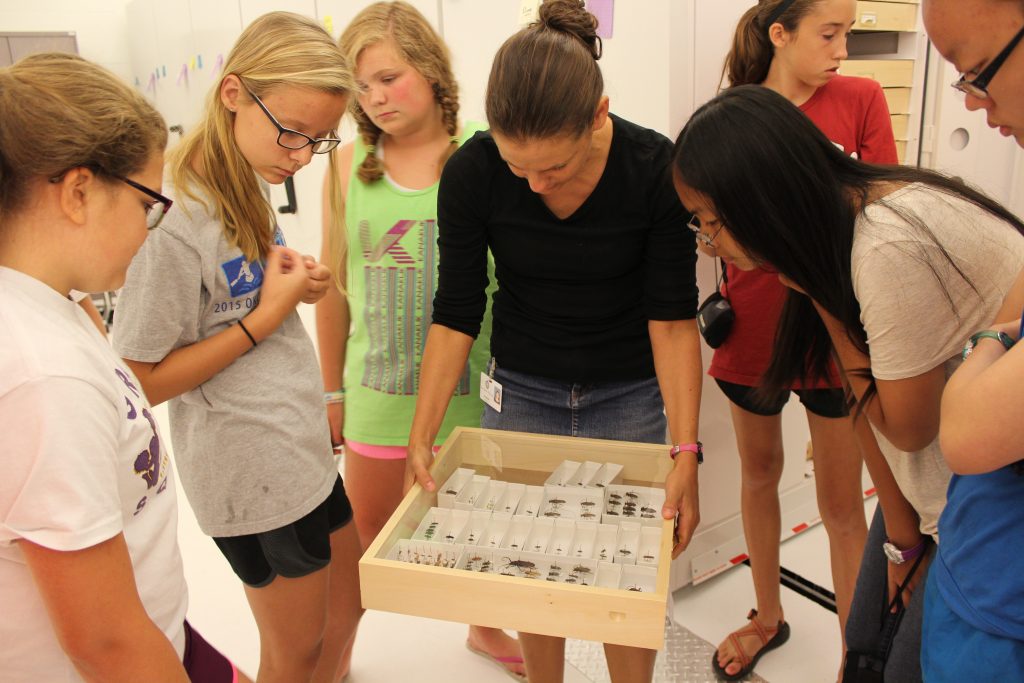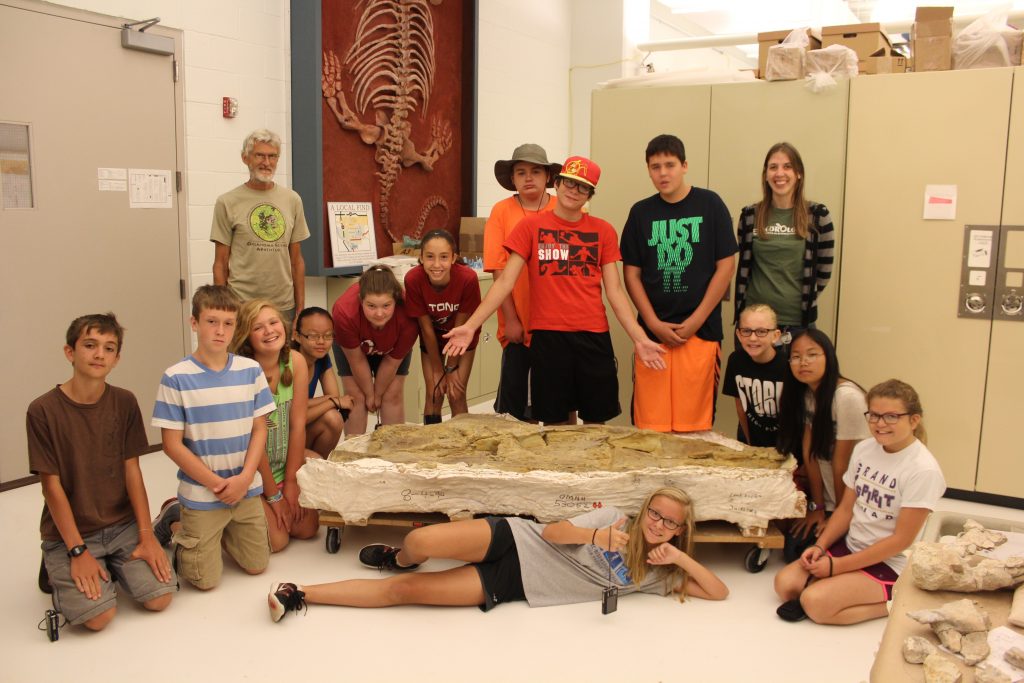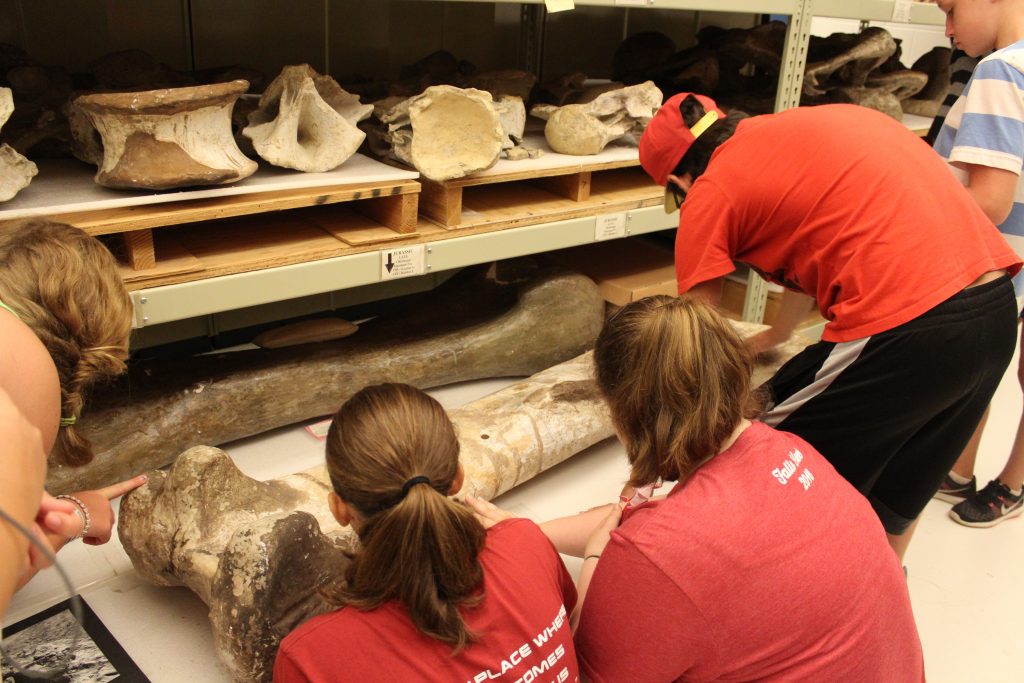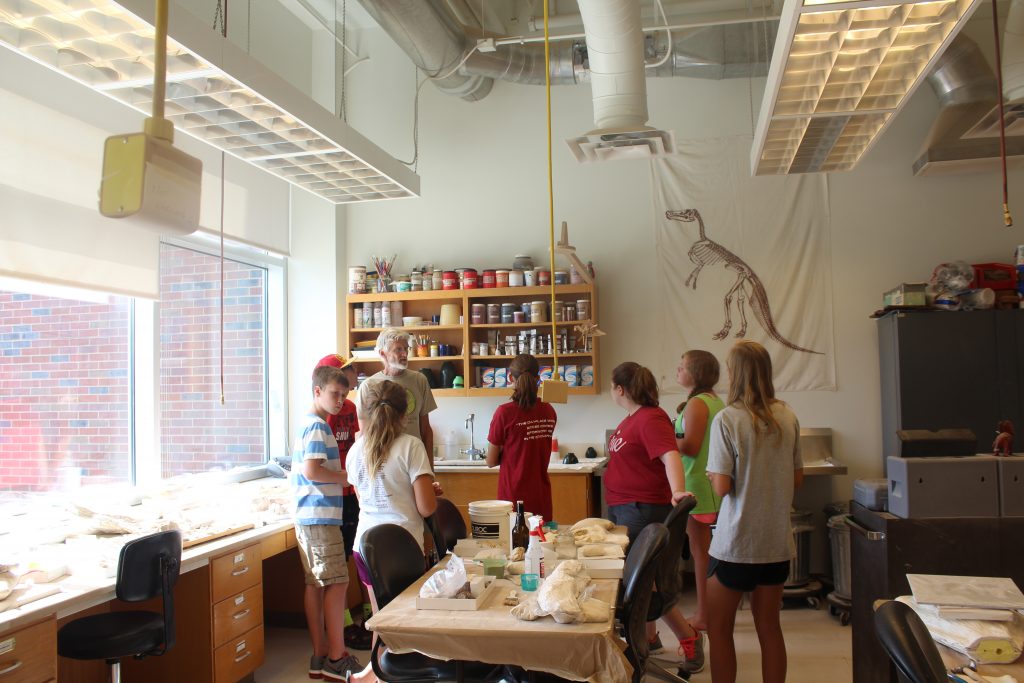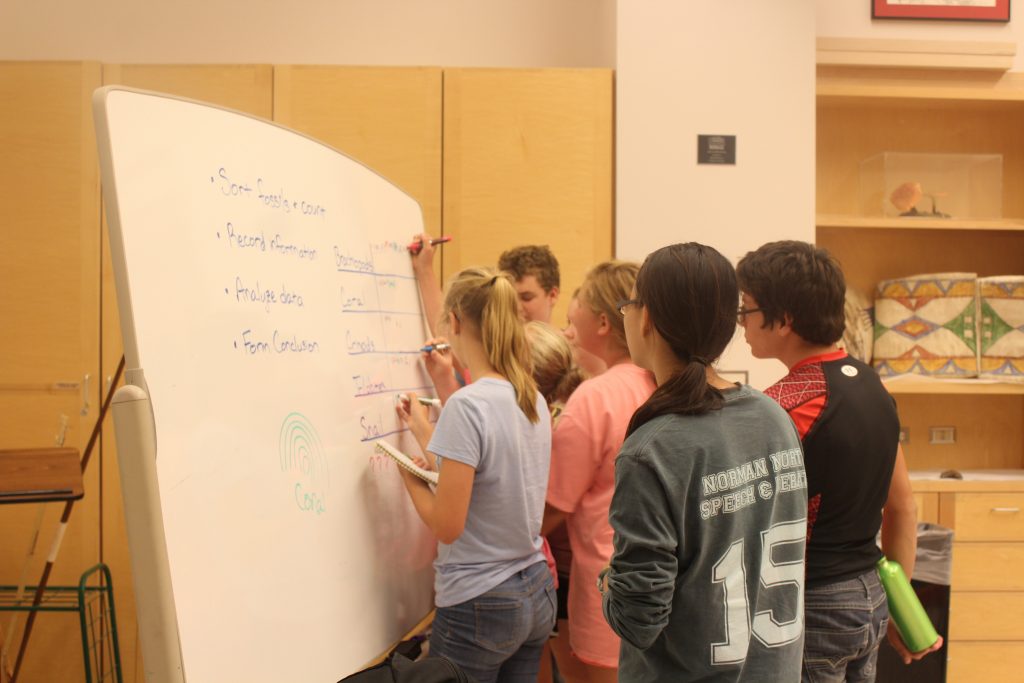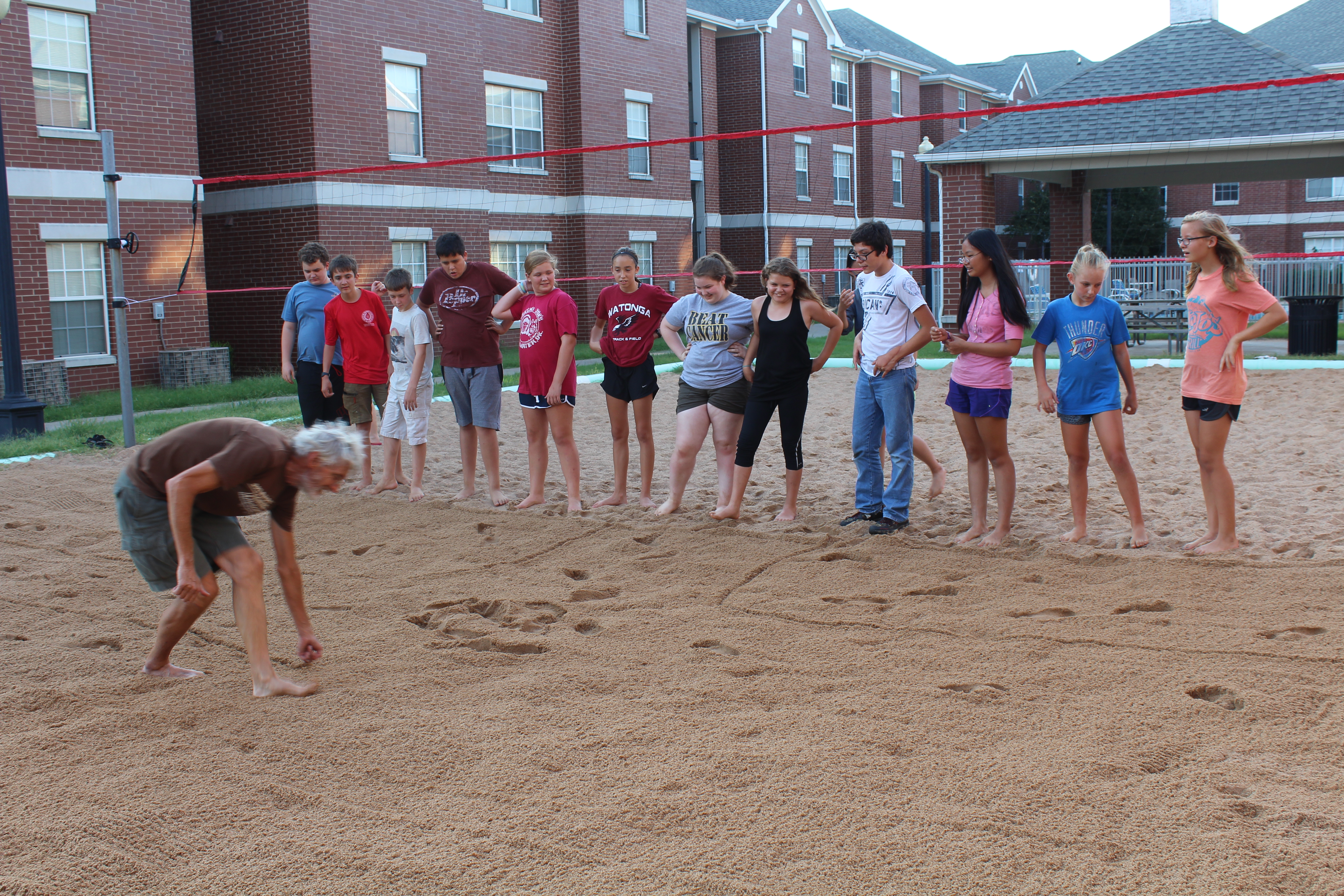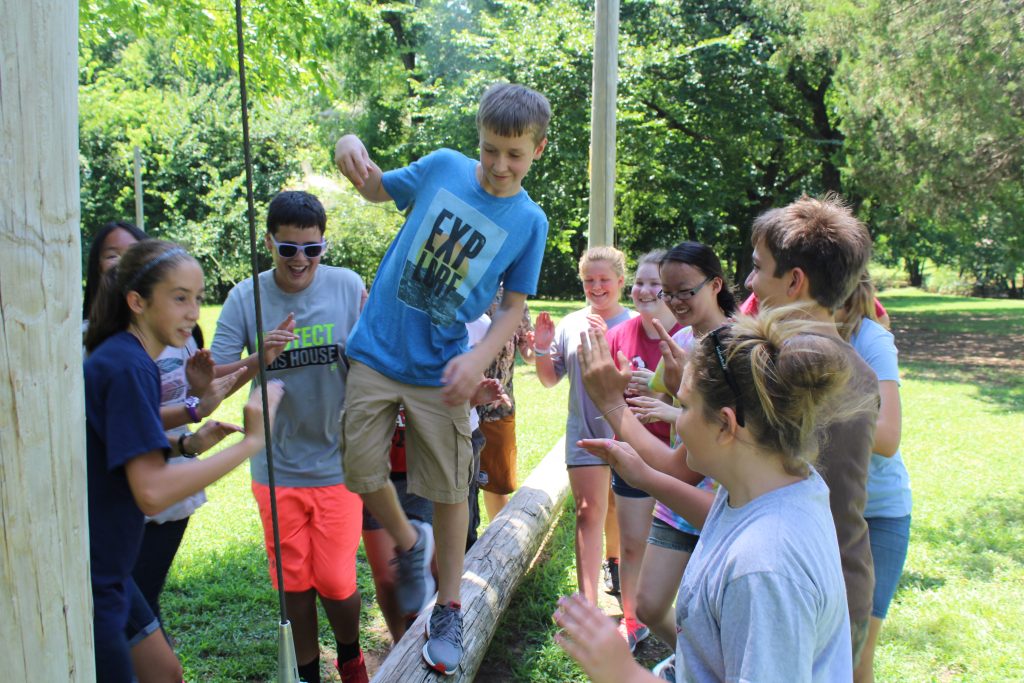Check out pictures from our 2016 adventure!
Oklahoma Science Adventure 2016 Blog
July 10
Oklahoma Science Adventure 2016 hit the ground running, and we are all having a great time! We spent Sunday afternoon learning about teamwork and communication at the OU Ropes course, before heading out to the Rogers County Conservation District in Claremore. We will spend the next couple of days learning about the scientific method and field research before developing research projects of our own (with the help of our scientist mentors!). Check back tomorrow for updates as our field research continues!
July 11
Our first day in the field was a success! After studying different ecosystems found in the Conservation District, we are designing our own research projects to get a better understanding of ecology and field science. We asked our participants: what qualities, characteristics or skills do you think someone needs to be a scientist?
Riley C.: Some characteristics that someone needs to be a good scientist is that they need to be observant and be able to analyze different things. They also need to enjoy and be passionate about what they do.
Isabel S.: I think a scientist needs several qualities including, Courage because you need to be brave enough to be able to go out into the field and get dirty and a little bit wet! Another quality I think a scientist should have, if working in an outdoor field, should be that the person should be nature friendly to better preserve the area they just entered.
Jimson S.: They need to be flexible, have a good attitude, and be fun.
Caden C.: The qualities, characteristics or skills I think would be able to make hypothesis about a certain subject, and would have to know the details of the subject
Micah P.: They need to be able to adjust to the situation be able to work in a team and be knowledgeable of their field
Brooke S.: I think that a scientist needs to be observant of their surroundings. They need to be comfortable with what they’re doing. They also need to know what they’re doing. You have to love your line of work. Being brave really helps with exploring the unknown.
Taylor M.: I don’t think you have to have any required skills. Anyone who wants to be a scientist can be one you just have to put in the work. You need to have will power and trusting in yourself. Taking criticism well is also something that will help you be a good scientist. You just have to be confident in yourself to be scientist, that’s really all you need to be to be a scientist.
Lindy G.: Qualities and characteristics a scientist needs is, first, knowledge in subjects such as math, geography, and of course, science. Secondly, an open mind. Third, a willingness to get dirty when necessary. And lastly and most importantly, a passion for what they do and study whether it be aquatic animals, insects, plants, or desert ecosystems.
Calvin W.: What qualities, characteristics or skills do you think someone needs to be a scientist? An enthusiasm for their field, an ability to adapt, and a lot of patience. If a subject interests you, then it may never become tiresome. However, everything has it’s difficult parts, and it is important to never give up or lose interest simply because of a more challenging aspect of an otherwise quite enjoyable subject. Nothing is completely fun and games, but if you are able to adapt and push through a more difficult part of a subject, than mastery is just around the corner.
Emily M.: A scientist can be anyone. You don’t have to have any special skills or qualifications, as long as you’re interested in what you are studying. It’s always helpful to know some extra facts, but you can always start from the beginning and learn something new. All you need is to have interest in what you are studying and confidence in what you know.
Blane L.: I think that if you want to or are going to be a scientist you need to be able to press your boundaries and be able to get wet and dirty.
Julia H.: In my opinion, the necessary characteristics for someone who wishes to be a scientist are to have the ability to cooperate and communicate, the willingness and passion to learn and explore, and the knowledge that will open doors to even more knowledge.
Riley L.: I think someone should be able to be a leader, but can also can be a listener. They should also be hardworking. The last quality is they should be able to have fun.
July 13
We can’t believe Oklahoma Science Adventure is halfway over – time flies when you’re having fun studying science! Yesterday we conducted research projects at the Rogers County Conservation District, where we were able to learn about modern environments and ecosystems as well as field research (not to mention a lot of mud!). We were joined also by our scientist mentor Dr. Nick Czaplewski, the museum’s curator of Vertebrate Paleontology, who joined us on our early morning observation hike as well as our canoe trip today! It’s been a busy two days of science, nature, and fun, but we have enjoyed every minute of it. We asked our participants: What has been your favorite part of Oklahoma Science Adventure so far, and why?
Jimson S.: My favorite part so far was canoeing because it’s be a while.
Taylor M.: My favorite part of OSA has been the people I have met. I have met so many new friends that I know I will been in touch with for the rest of my life. I have also loved the car rides to and from the different places. From the inside jokes to the late night talks, I am so happy to meet all of these new and amazing people.
Emily M.: Man….I don’t know if I can even choose just one part! This whole week has been such a blast. One of my favorite parts was doing our nature at dawn trip, where we got up at four a.m and watched all the animals and insects at the reserve wake up. The stars were so stunning, and even though I struggled to stay awake, it was well worth it. I also loved canoeing down the Illinois River. We hit a few bumps (giant trees, anyone?), the beautiful scenery was a sight to behold. And man, did that water feel good. I can’t believe OSA is almost over, but I can believe I have made friends and memories for a lifetime.
Riley C.: My favorite part of OSA so far has been getting to observe the wildlife at the reserve. The wildlife there was very interesting and I enjoyed conducting experiments about the fish. I love to observe animals in their natural environment, and many of the wildlife at the reserve I have never been able to observe this close before. I can’t wait to see what else fun and interesting things we are going to do.
Riley L.: My favorite part so far has been the the canoeing. The reason why is because it was a lot of fun. Also I was with a very good partner, who is very patient and had done it before. She was also a very good teacher. One other good part about canoeing was that we went on a 3 hour ride. It was long enough that I had fun but, not to long that it was boring.
Isabel S.: I don’t really have a favorite part because I can’t chose one but, I had a lot of fun making/doing our project, (Riley L. & I), on animal tracks. It was really fun because we got to get dirty and do something we liked to do! I am also VERY happy to be making all of these new friends! I have had a lot of fun this week so far and i would like to say thank you to ExplorOlogy for letting me be able to come to this program!
Lindy G.: My favorite part of the Oklahoma Science Adventure was when we went canoeing because it was an interesting experience and a excellent way to learn new things.
Micah P.: My favrorte part has been the canoein, that was very fun. I got to hang out with my friends and just be outside.
Blane L.: My favorite part so far is the canoes it was my favorite because being able to lots of things in the same area.
Brooke S.: I’ve had a lot of fun exploring river and lake ecosystems. My favorite part of ExplorOlogy so far has been getting over my fears of Insects and being able to work with them.
Julia H.: During my time at this camp, I had many favorable memories. However, the most memorable event was the canoeing trip, which occurred today. We canoed for 6 miles; and although canoeing for 6 miles take time and energy, it was enjoyable because I was surrounded by my new friends and swimming in the river in which we canoed in was interesting.
Calvin W.: My favorite part so far has been when we were doing our research projects. O.S.A. supplied all the equipment necessary for whatever project we chose to try, and encouraged us to push our comfort zones. We met real scientists who helped us with the more difficult parts of our projects, from identifying animal tracks, to counting microorganisms. We sampled from ponds, caught tadpoles and insects, and caught fish with seine nets. It was a blast! Thank you, thank you, thank you O.S.A.
Caden C.: Yesterday was very fun, we got to met a mentor Nick. We learned about tracking. what we did today was we first woke up at 4:00 am to observe animals waking up, then we went canoeing down the Illinois river. My canoeing partner and I may have flipped but was handled greatly by our mentors. Today was a great experience.
July 14
Today, Nick helped us to collect fossils of ancient animals without backbones – crinoids, corals, brachiopods and trilobites. We all worked together to decided on a research question, and then collected the fossils we needed to answer our question. Now that we’ve made it back to the museum safely, we’re excited to start working on our presentations for Saturday so that we can show our families what we have discovered! We asked our participants: describe your White Mound research project to your friends and family (hint: remember the scientific method!).
Brooke S.: It was amazing collecting fossils, but before we went out into the field, we spent an hour or two the night before coming up with a question and a hypothesis. We found a diverse range of fossils at White Mound. A few examples are Trilobite, Coral, Crinoids, Brachiopods. It was a great experience and I loved learning about the world and what lived on it millions of years ago.
Lindy G.: The White Mound research project was a project based on the number of fossils there were at the site. First, we asked a question: Which type of fossil is the most numerous at the White Mound? Then, we made a hypothesis: the brachiopods (clam-like creatures) would most be the most common fossil. Next, we actually went to the mound and made observations while walking around the mound. After that, we decided on a method or procedure in which to perform the experiment: each person will choose a 1×1 meter square to collect the fossils. Everyone would have 30 minutes to collect as many fossils as possible. When the 30 minutes was over, we went back to the Sam Noble Museum to record our findings. We counted the number of brachiopods, trilobites, coral, crinoids, and other fossils we had collected. Ultimately, there actually were way more brachiopods than any other fossil (1,381 brachiopods)! We created a pie chart to compare the number of fossils and wrote a conclusion summing up the whole experiment.
Isabel S.: For our group project the first thing we did was create a question for the project. Our question was, “Which of the four common types will be the most common?”. Next we had to look at some fossils that we had and make some observations on the fossils. Then we had to make a hypothesis and it was,”We think that the most common type of fossil will be brachiopods.” After that we needed to make a plan, so we chose to make a designated area for each person to search for fossils for 30 minutes. Next we needed to test our hypothesis. Then we needed to look at our data and our hypothesis was supported! We found more and 1,000 brachiopods all together!! Finally we looked at all of our data and we found A LOT of fossils! We ended up with 1,552 fossils overall!
Julia H.: The White Mound research project was performed by all 13 participants. The question was: Which of the 4 fossils – crinoids, corals, brachiopods, and trilobites- is the most common? Then, after some discussion, we settled on a hypothesis, which claimed that the brachiopods were the most common. From then on, we began deciding on the method and materials. The next day, we traveled to a fossil site to excavate. All 13 participants spent 30 minutes excavating the fossils on the site within 1 square meter apiece in order to keep a control variable. Afterwards, we counted and sorted the fossils. As a group, we then made a data table and a pie graph that showed the number and percentage of each type of fossil. With this data, we wrote a conclusion, which consisted of supporting our hypothesis.
Caden C.: Today was great we woke up and drove from Tahlequah to Sulphur. For the area we looked for fossils, we made a hypothesis that the most common fossil would be the Brachiopod. The hypothesis was supported very much, and we had help by Nick one of the mentors. Our research was between four types of fossils. Then we drove back to the museum where all of us wrote down in our journal about our experience . Finally we ate at the famous Chili’s (the new one in Norman).
Calvin W.: The White Mound research project. Man! That was fun! We first chose a question: Which of each of the four common fossil types (Trilobite, Coral, Crinoid, and Brachiopods) are the most common in the White Mound fossil digging site? Our hypothesis was that the Brachiopods would be most common. We decided to measure this by assigning each person a one meter square in various parts of the site to take samples and count the various types. When we arrived, we sampled as planned, and brought the fossils back to the Sam Noble Museum to count and chart them (as well as some well preserved fossils we found for ourselves). Our results; 1,381 Brachiopods, (89%) 99 Chorals, (6.4%) 21 Snails, (1.37%) 12 Crinoids, (0.80%) and 8 Trilobites (0.5%). As you can see, the data supported our hypothesis, with Brachiopods coming in a strong first. And boy! that was so fun!!! We could keep any of the fossils we found, and some of us found whole Trilobites! (Which are really rare!) Thank you, ExplOrogy! Thank you thank you thank you!!!!!
Riley L.: First, we asked a question. How many fossil of each of the four common types? Next step was our hypothesis. Our hypothesis was we thought the there would be more Brachiopod fossils. The third step was our planning. We said to ourselves that we will have to wait till we got to the site to decide how much space we would get. The fourth step was to test our hypothesis. What we did to test our hypothesis was go out to our site and we each got a 1×1 meter space to see which would be the most common fossil. The final step was to analyze our research. We analyzed our data by counting the numbers and seeing which one had the most. Our final result was the Brachiopod was the most common fossil. I had so much fun. The best part of the day was finding a segment of a Trilobite. The reason why is because the are not very common.
Riley C.: First, we came up with a question, ”Which of the four fossils is the most common?”. Second we came up with a hypothesis, our hypothesis is ”Of the four fossils we think the brachiopods will be the most common”. Third, we planned out how we conduct our experiment. We decided how long we would dig and how big of area we would have to dig. Then, we went and collected our fossils at the site. When we were done collecting we drove back to the museum and sorted and counted the fossils. After we were done we analyzed the data and we discovered that our hypothesis was correct; we found the most brachiopods at the site. In fact, 89% of our fossils were brachiopods. This was an amazing, fun experience and I would defiantly do it again(even though it was super hot!)
Blane L.: The Mound research was a bare place with many minerals and fossils all over the ground. It was not just bare, it was hot! We were looking for the most common fossil of the the four fossils; we spent 30 min. looking, and ended with 1,552 fossils including brachiopods, coral, crinoids, trilobites, and snails. Our most common fossil was the brachiopods.
Emily M.: Today was really fun, and super interesting. We were told yesterday that we would be conducting our own research project as a group, so it was up to us to come up with things like a question and a hypothesis. We finally decided on our hypothesis: the most common type of fossil would be a Brachiopod, which looks like a shell. We went out to the field, and began our search. We decided that we would all spend thirty minutes looking for fossils in our own little box. Then we went back to the museum to sort out all of our fossils, and come to our conclusion, which was that our hypothesis was, in fact, supported: Brachiopods were the most common. They made up 89% of our findings! I think the most exciting part was when I found two parts of a Trilobite and when I found a whole Crinoid, because those were the two least common types of fossils found. It was interesting comparing our findings with each other, and making discoveries of our own.
Micah P.: For our White Mound research project, first we asked our question which was what was the most common fossil out of four types of fossils (Brachiopods, Coral, Crinoids, and Trilobites). Then we came up with our hypothesis which was that Brachiopods were the most common. Then our method was each person got a square meter to look for fossils with and got thirty minutes. Then our data was that 89% of our fossils were Brachiopods than 6.4% were coral then 2% were unknown then 1.3% was Snails then 0.8% was Crinoids then the last 0.5% was Trilobites. So then in conclusion our hypothesis was supported very strongly with Brachiopods in first place, and ExplorlOrogy has been very fun so thank you for so much fun!
Jimson S.: The White Mound research project was a project where we got to be paleontologists. First, we had a question of “What fossils are more numerous there?” We formed a hypothesis that brachiopods would be the most numerous. Then we went to White Mound where we conducted our experiment. We spread out and set up 1 meter by 1 meter squares; we searched for fossils for 30 minutes in our squares. We came back to the museum and counted our fossils. Our hypothesis was supported; we had 1381 brachiopods out of the 1552 fossils total.
Taylor M.: The White Mound Research Project was where we went out into the field to find and collect fossils of various invertebrates. Before we went out to the field we went to the hotel conference room to plan what we need to do. We discussed what kind of questions we had about fossils and why. We worked as a team to get the question “Which of the four kinds (Brachiopods, Crinoids, Coral, and Trilobite) was the most common fossil at the site?” Once we agreed on a question we worked on a hypothesis and how to answer this question. We thought that we would find the most Brachiopods, which are things like shells. we also covered most of the concerns we had, had to be answered on site. A few of the concerns we had were how big of an area each person would get and how long we would be looking. When we got there we decided that each person would get one square meter per person and each person would search for 30 minutes. We searched, collected and headed back to the museum to count and sort. When we started sorting we soon realized that are hypothesis would be supported, as we found 1,381 Brachiopods. Our least common find was Trilobites, which are not as common as Brachiopods (we ended up only finding 8). To conclude, we were right in our hypothesis and Brachiopods were most common. We did also find 1,552 fossils in total between the 13 of us.
July 15
We can’t believe the last day of Oklahoma Science Adventure is almost over! After a week out in the field, we spent today back at the museum to see how field research is translated to the public by touring the galleries and collections. We were also joined by Tim Munson from the Oklahoma Energy Resources Board (OERB), who taught us about geology and natural resources. Who knew that so many different types of science were connected! Before we say goodbye tomorrow, we asked our participants; if you could be any type of scientist (or study any particular subject), what would you choose and why?
Calvin W.: Any type… I would undoubtedly be an astrophysicist. I am deeply interested in astrophysics, and have been ever since my early childhood. I hold a deep fascination for deep space, and all it’s mysteries, and the endless possibilities and questions just waiting to be answered. I was introduced to astrophysics first by Carl Sagan, in his television show, “Cosmos”. Ever since, everything astrophysics related has popped out at me from anything I hear and read. The subject is amazing! I love every aspect of it.
Riley C.: If I could be any type of scientist I would be a zoologist. I really love animals and would enjoy working with them. I would want to help heal the sick animals at the zoo. I have wanted to work with animals since I was little, and being a zoologist is a perfect job for that!
Taylor M.: I would want to be a Zoologist. I like the study of live animals and how to treat them. Animals can teach us things that humans won’t pick up on. We don’t realize how smart animals actually are until we start to study and analyze them. I believe that working with the animals can show us a whole new side of nature that we don’t realize is there at first glance.
Julia H.: Even from when I was 10 years old, I have wanted to pursue a career of pharmacy. The reason behind my chosen career was because I wanted the knowledge of various types of medicine and be able to help those around me. Even though the required amount of schooling is more than I would wish for, I believe it is well worth the benefits that come afterwards.
Riley L.: I would chose to be a geologist. The reason why is because I think that the study of rocks is very interesting; reason why I like rocks are because they can come in a very wide variety. When I study rocks it just feels normal. It is more fun vs hard work.That is why I think that I would want to study geologist.
Lindy G.: If I could be any type of scientist, I would be a marine biologist. I like animals and would love to study them more. The reason I would choose to be a marine biologist instead of a zoologist is because I enjoy swimming and would like to spend most of my time in the ocean or any other body of water. I believe this is an excellent career for me since I adore helping others, humans and animals alike.
Emily M.: I would study Paleontology or Zoology because I have always been interested in animals of all types. Paleontology would be fun because it’s always really interesting to look back into the past and see what types of animals lived and how they lived. I would also love to study Zoology because I love animals, and it would be cool to study them.
Blane L.: If I were to choose any type of scientist I would be a archaeologist. I would choose an archaeologist because I want to be able to study ancient civilizations like the Incas.
Caden C.: Today is the last day ;( but we still had a lot of fun by touring the museum, galleries, and private collections. We also saw the labs and Dr. Katrina Menards collection of insects. Then we will watch a movie (Night of The Museum). If I could be any type of scientist I would be a biologist; I’d love to a ER Physician. Even in my early childhood I wanted to be a Doctor.
Jimson S.: I would be a paleontologist, because I like to study rocks and fossils. Fossils show us what life was like in the past.
Isabel S.: If I had to chose JUST one type of scientist to be when I grow up I would chose to be a paleontologist. I would like to be a paleontologist because I want to discover new species and find the fossils of ancient animals and insects. I also think it would be fun to study ancient life. I also think that I should do something I actually like to do for my job, not something I don’t like. That is why I want to be a paleontologist in the future.
Micah P.: if i became a scientist i would have to chose to be a zoologist because i love animals and i would liked to study them an learn more about them and maybe discover some new ones.
Brooke S.: I’d be an Astronomical- Geological- Paleontologist, that travels Mars and maps the surface. Because I love different categories of science, the reason I would go to Mars is because I love space/ the solar system and it would be awesome to be one of the first people on an uninhabbited planet .







